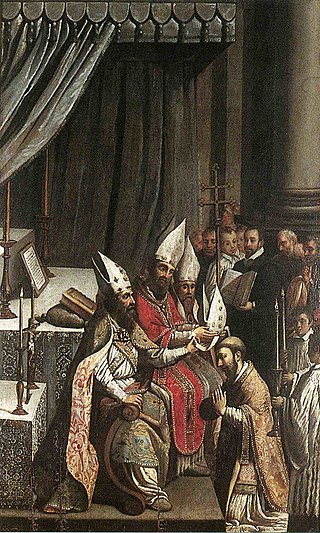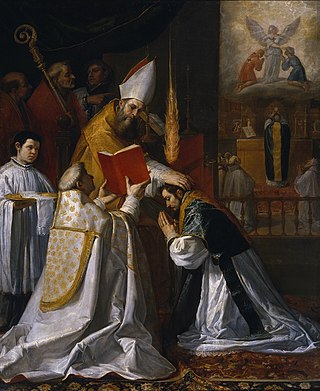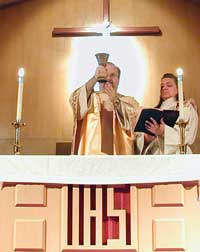Background of Methodism in the U.S
Prior to the revolution, American Methodism consisted of itinerant preachers commissioned by John Wesley the founder of the Methodist societies in England. Wesley had been sending preacher/missionaries since the 1760s. With the outbreak of war, most of these returned to England, with the exception of Francis Asbury and James Dempster. Asbury began to be looked upon as the leader of the groups, whereas Dempster moved to upstate New York, where he ministered locally. His activities were greatly restricted because, as an Englishman, he was suspected of not being sympathetic to the patriot cause. During the war, he ceased his circuit riding and stayed at the residence of his friend, Judge Thomas White of Delaware.
Before the war, the Methodist itinerant preachers were appointed to form societies, but they were expected by Wesley to work within the Anglican Church, as they were not ordained. They were not allowed to administer the sacraments. This produced some difficulty as Anglican Churches were limited to the coastal cities, and the itinerant preachers were moving westward and inland. Similarly the Anglican clergy almost all left for England with the outbreak of war.
Asbury had come to America in 1771. Under his leadership, conferences were formed and American preachers appointed, but this did not solve the problem of the administration of the sacraments.
During the war, the societies continued to grow, albeit more slowly due to all the disruptions. Following the war, there was a move to locally ordain the preachers, but Asbury counselled patience until Wesley gave direction.
Invitations and conference
Meeting with Asbury on November 14, 1784, Coke explained Wesley's intentions and proposed to ordain him. Asbury, catching the spirit of democracy in the new country, refrained from accepting the ordination until approved by the American connexion. Messengers were sent, calling the American itinerants to Baltimore on December 24. Eighty one preachers were entitled to membership; nearly sixty of them were able to arrive for the conference. [1] During the six weeks while waiting for the conference, Coke and Asbury went on a preaching tour (on horseback) that covered at least 900 miles. [2]
With the Christmas Conference's unanimous approval, Asbury was ordained and appointed as co-superintendent. He was ordained deacon on Christmas Day by laying on of hands; elder on the next day; and superintendent the next. Asbury's friend Philip William Otterbein, pastor of the German Reformed Church of Baltimore, also laid hands on Asbury to assist in the ordination. [3]
Coke later said of Asbury, "In the presence of Mr. Asbury, I feel myself a child. He is in my estimation, the most apostolic man I ever saw, except Mr. Wesley." Coke preached Asbury's ordination sermon, which was later published and caused some stir in England because he emphasized the need to ordain only godly men, and pointed to England for an example of immoral and unconverted men to orders.
Results and legacy
This conference, which became known as the first General Conference of the new church, abridged the 39 Articles of Religion of the Anglican Church into 24, added one additional article regarding civic duties as US citizens, and adopted these articles as its governing principles, also known as the Discipline. They also received a modified prayer book sent by Wesley. [4]
John Dickins a pastor in New York proposed the name of the fledgeling church: the Methodist Episcopal Church.
The conference also ordained 12 preachers to orders, setting a precedent for the American church that ordinations were to be approved by the conference.
Immediately after the ten-day conference, Asbury set out circuit riding as he had before the war. His first destination was Charleston, South Carolina which he deemed the city most in need of spiritual enlightenment.
The American church held another General Conference in 1792 and every four years after.

Apostolic succession is the method whereby the ministry of the Christian Church is held to be derived from the apostles by a continuous succession, which has usually been associated with a claim that the succession is through a series of bishops. Those of the Anglican, Church of the East, Eastern Orthodox, Hussite, Moravian, Old Catholic, Oriental Orthodox, Catholic and Scandinavian Lutheran traditions maintain that "a bishop cannot have regular or valid orders unless he has been consecrated in this apostolic succession". These traditions do not always consider the episcopal consecrations of all of the other traditions as valid.

In certain Christian denominations, holy orders are the ordained ministries of bishop, priest (presbyter), and deacon, and the sacrament or rite by which candidates are ordained to those orders. Churches recognizing these orders include the Catholic Church, the Eastern Orthodox, Oriental Orthodox, Anglican, Assyrian, Old Catholic, Independent Catholic and some Lutheran churches. Except for Lutherans and some Anglicans, these churches regard ordination as a sacrament.
The United Methodist Church (UMC) is a worldwide mainline Protestant denomination based in the United States, and a major part of Methodism. In the 19th century, its main predecessor, the Methodist Episcopal Church, was a leader in evangelicalism. The present denomination was founded in 1968 in Dallas, Texas, by union of the Methodist Church and the Evangelical United Brethren Church. The UMC traces its roots back to the revival movement of John and Charles Wesley in England, as well as the Great Awakening in the United States. As such, the church's theological orientation is decidedly Wesleyan. It embraces liturgical worship, holiness, and evangelical elements.

John Wesley was an English cleric, theologian, and evangelist who was a leader of a revival movement within the Church of England known as Methodism. The societies he founded became the dominant form of the independent Methodist movement that continues to this day.

Francis Asbury was one of the first two bishops of the Methodist Episcopal Church in the United States. During his 45 years in the colonies and the newly independent United States, he devoted his life to ministry, traveling on horseback and by carriage thousands of miles to those living on the frontier.

The Methodist Episcopal Church (MEC) was the oldest and largest Methodist denomination in the United States from its founding in 1784 until 1939. It was also the first religious denomination in the US to organize itself on a national basis. In 1939, the MEC reunited with two breakaway Methodist denominations to form the Methodist Church. In 1968, the Methodist Church merged with the Evangelical United Brethren Church to form the United Methodist Church.

A Methodist local preacher, also known as a licensed preacher, is a layperson who has been accredited by the Methodist Church to lead worship and preach on a frequent basis. With separation from the Church of England by the end of the 18th century, a clear distinction was recognised between itinerant preachers and the local preachers who assisted them. Local preachers have played an important role in Methodism since the earliest days of the movement, and have also been important in English social history. These preachers continue to serve an indispensable role in the Methodist Church of Great Britain, in which the majority of church services are led by laypeople. In certain Methodist connexions, a person becomes a local preacher after obtaining a license to preach. In many parts of Methodism, such as the Allegheny Wesleyan Methodist Connection, there are thus two different tiers of ministers—licensed preachers and ordained elders.

Richard Whatcoat was the third bishop of the American Methodist Episcopal Church.
A bishop is a senior role in many Methodist denominations. The bishop's role is typically called the "episcopacy", based on the Greek word episkopos (επισκοπος), which literally means overseer. Superintendent is another translation of episkopos but in Methodist churches this is a role distinct from bishop. The first Methodist bishops were appointed in America, and American Methodist denominations still recognize the office of bishop.

Barratt's Chapel is a chapel located to the north of Frederica in Kent County, Delaware. It was built in 1780 on land donated by Philip Barratt, owner of Barratt Hall, and a prominent local landowner and political figure. Barratt, who had recently become a Methodist, wanted to build a center for the growing Methodist movement in Delaware.

Thomas Coke was the first Methodist bishop. Born in Brecon, Wales, he was ordained as a priest in 1772, but expelled from his Anglican pulpit of South Petherton for being a Methodist. Coke met John Wesley in 1776. He later co-founded Methodism in America and then established the Methodist missions overseas, which in the 19th century spread around the world.

An elder, in many Methodist churches, is an ordained minister that has the responsibilities to preach and teach, preside at the celebration of the sacraments, administer the church through pastoral guidance, and lead the congregations under their care in service ministry to the world.

St. George's United Methodist Church, located at the corner of 4th and New Streets, in the Old City neighborhood of Philadelphia, is the oldest Methodist church in continuous use in the United States, beginning in 1769. The congregation was founded in 1767, meeting initially in a sail loft on Dock Street, and in 1769 it purchased the shell of a building which had been erected in 1763 by a German Reformed congregation. At this time, Methodists had not yet broken away from the Anglican Church and the Methodist Episcopal Church was not founded until 1784.

James O'Kelly was an American clergyman during the Second Great Awakening and an important figure in the early history of Methodism in America. He was also known for his outspoken views on abolitionism, penning the strong antislavery work, Essay on Negro Slavery.

Wesleyan theology, otherwise known as Wesleyan–Arminian theology, or Methodist theology, is a theological tradition in Protestant Christianity based upon the ministry of the 18th-century evangelical reformer brothers John Wesley and Charles Wesley. More broadly it refers to the theological system inferred from the various sermons, theological treatises, letters, journals, diaries, hymns, and other spiritual writings of the Wesleys and their contemporary coadjutors such as John William Fletcher.

Methodist views on the ordination of women in the rite of holy orders are diverse.
The Allegheny Wesleyan Methodist Connection (AWMC), originally the Wesleyan Methodist Church (Allegheny Conference), and also known as the Wesleyan Methodist Church (WMC), is a Methodist denomination within the conservative holiness movement primarily based in the United States, with missions in Peru, Ghana, and Haiti.

The history of Methodism in the United States dates back to the mid-18th century with the ministries of early Methodist preachers such as Laurence Coughlan and Robert Strawbridge. Following the American Revolution most of the Anglican clergy who had been in America came back to England. John Wesley, the founder of Methodism, sent Thomas Coke to America where he and Francis Asbury founded the Methodist Episcopal Church, which was to later establish itself as the largest denomination in America during the 19th century.

Harry Hosier, better known during his life as "Black Harry", was an African American Methodist preacher during the Second Great Awakening in the early United States. Dr. Benjamin Rush said that, "making allowances for his illiteracy, he was the greatest orator in America". His style was widely influential but he was never formally ordained by the Methodist Episcopal Church or the Rev. Richard Allen's separate African Methodist Episcopal Church in Philadelphia.
The Bible Methodist Connection of Churches is a Methodist denomination within the conservative holiness movement.













